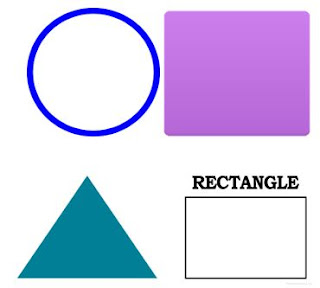Welcome back to School
Objectives:
- Requesting Objects
- Requesting Permission
- Introducing yourself
- Reviewing shapes and numbers 1-5
Values:
Being neatPhonic area
Beginning sound “s”Cross. Curricular
Art
Learning development activities> Mathematical Thinking: Use numbers in diverse situations that draw on the principles of counting.
> Language and communication: Identify characteristics of the writing system.
- Requesting Objects
- Requesting Permission
- Introducing yourself
Requesting Objects
Choose one student
Show one object and demonstrate a short dialogue.
Teacher: Can I have a pencil please?
Student: Here you are
Teacher: Thank you
Select other volunteer and practice again with other object.
Requesting Permission
Use the puppets to ask permission but first tell them that they wish to use the Restroom. Practice the dialogue with puppets, then encourage children to practice the dialogue in pairs for a few minutes. Then invite a few pairs to the front to perform their dialogue.Teacher: Of course
Introducing yourself
Present to the class two puppets. Name them (for example: Susy and Lily) and select two students to make a dialogue in front of the class.Student 1: Hello, Susy. My name´s (Oscar)
Lily: Hi I´m Lily. What´s your name?
Student 2: Hello Lily, My name´s (Aisha).
Reviewing shapes and numbers 1-5 Class
Draw a circle, triangle, rectangle and square on the board. Elicit the names of the shapes. Ask children to listen and then look around the classroom to find objects of the corresponding shapes.Game:
Teacher: I spy with my little eye… (a circle)Student: (point to a chair) Look!
Teacher: No, that´s not. Keep looking!
Student: (pointing to a picture of the sun) Look!
Teacher: Yes, that right!
Repeat with square, rectangle and triangle.
Extra Material
Introducing yourselfCreating a name tag.
Games:
Encourage the students to cut the corresponding tag, write each child´s name on their name tag in pencil, if a child knows how to write his or her mane, allow him or her to do so in pencil.Distribute markers or glitter glue. Ask children to trace carefully over their name with a marker or glitter glue. (Allow time to the glitter glue to dry). If you don’t have enough time use markers only.
Help children punch holes in their name tag and tie a piece of yarn through the holes so that they can hang their name tag around their neck.
Circle of Introductions:
Make sure every child is wearing his or her name tag and have children form a circle. Start by introducing yourself. Then have each child around the circle introduce himself or herself.Teacher: Hi My name is Susana, (asking the child on your left) What´s your name?
Student: Hi! My name is Oscar (asking the child on his left) What´s your name?
Bag Down - Game to Introduce
Go around the class and whisper the name on each child´s new name tag. Make sure every child knows whose tag he or she has. Then have children walk around the classroom asking What´s your name? When a child finds the name tag´s owner, her or she should return it and give a clap.
Working Visual- Spatial Intelligence
Distribute a sheet of paper to each child. Have children place their name tag in front of them. Ask them to copy their name on the paper with a crayon and to decorate it. (It doesn´t matter if children write their name correctly or not. This is an exercise in motor coordination and visual-spatial skills.) Allow for creativity.Phonic area
Beginning sound “s”
Silly Sally!
"Silly Sally went to town, walking backwards upside down." Silly Sally is a topsy-turvy cumulative tale about a girl who walks to town on her hands and starts a small parade.
It´s Silly Sally!
Have children form a circle. Ask a girl to play the role of Silly Sally. Give her a long sock to pull over one of her shoes. Have her stand in the center of the circle.
Encourage children to clap in rhythm while Sillly Sally hops around on the foot without the long sock and says Silly Sally again and again. Then invite another girl to play the role of Silly Sally and repeat the procedure.










Vienen mas clases
ResponderBorrar